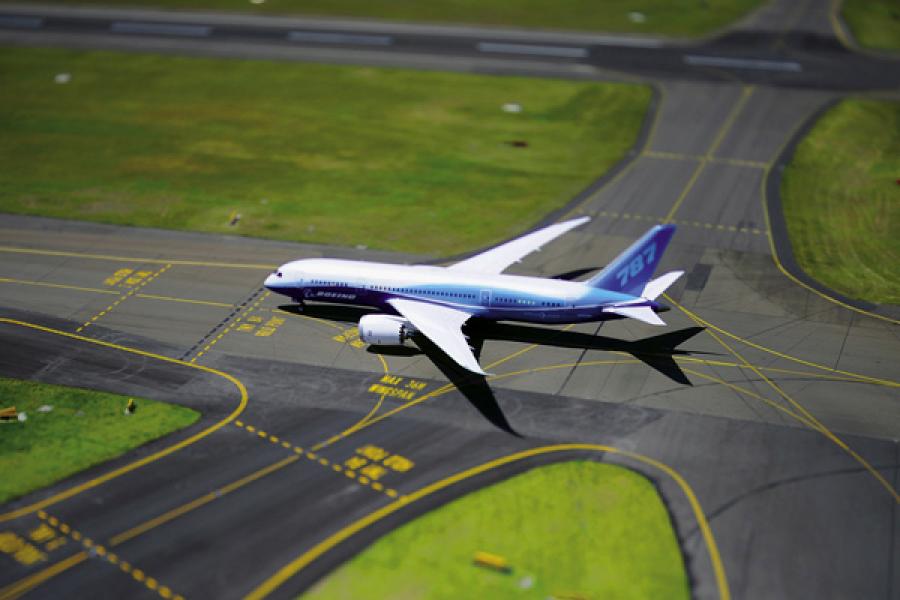
Fly the Dreamy Skies on the Dreamliner
Will Boeing’s long awaited Dreamliner change the game for international travellers?
Talk about flight delays: When All Nippon Airways (ANA) flight NH7871 departed Tokyo’s Narita Airport on Runway A last October 26, bound for Hong Kong, the airplane—a Boeing 787 Dreamliner—was more than three and a half years late. But its passengers were in a state of near rapture. One man, Gino Bertuccio of Miami, had paid $34,000 for a ticket (usual cost: About $1,000) at an online auction just for this moment, the Dreamliner’s much anticipated commercial debut. His fellow passengers, according to the Associated Press, “treated the experience like a rock concert, clapping after liftoff and snapping photos for posterity.”
You could say that expectations are sky-high for the 787 Dreamliner, a plane aviation observers—and Boeing top executives—hope will revolutionise air travel. One blog post on the well-respected website Airlinereporter.com called the Dreamliner “the iPhone of the aviation industry.” The plane’s coming-out party was supposed to have been in May 2008, but its unprecedented technical challenges—among much else, requiring 800,000 hours of design time on Cray supercomputers— repeatedly delayed delivery.
The more mundane headaches included orchestrating 50 suppliers at 135 manufacturing sites around the world and modifying a B747-400 to haul the major assemblies to the Dreamliner plant in Everett, Washington, (and, in so doing, creating the largest cargo plane by volume in the world). As time dragged on, some airlines cancelled, but most, including ANA, Singapore, Continental/United, Qantas and Air Canada, stood by their plane. As of February 2012, Boeing had received orders for 870 planes, worth an estimated $110 billion, making the Dreamliner the most successful commercial launch in aviation history. Boeing expects to deliver from 70 to 85 of the aircraft in 2012.
The carriers that kept the faith see the Dreamliner as not just an upgrade but also a revolutionary leap forward. For starters, the B787 is the first commercial jet not made primarily of metal. Fifty percent of the Dreamliner, including the entire fuselage and most of the wings, is fashioned from carbon-fibre-reinforced plastic. That makes the B787 far lighter than any plane of its size and allows it to cruise as effortlessly as an albatross. The trailing wing edge automatically optimises the airfoil shape during flight, and the wings actually flex upward by as much as 26 feet, making a bowl shape that allows the plane to perform like a glider.
The economic payoff is enormous—the 787 flies at the same 0.85 Mach top speed as the 777 but consumes 20 percent less fuel. That won’t necessarily translate into lower fares, but it means something just as valuable for the international passenger: Less travel time and fewer plane changes.
The B787’s increased range over the B777 will rewrite the world airline route map by enabling carriers to fly non-stop between cities that were formerly served through hub-and-spoke systems; Boeing has identified 450 airport pairs that could be connected for the first time with the B787.
Continental/United, for instance, the first US carrier to get the B787 (it expects delivery in the second half of 2012), has already announced plans to fly non-stop from Houston to Auckland and Houston to Lagos.

From left:a palette of lighting options;that’s (economy) entertainment;Boeing’s premium cabin mockup
Boeing has worked hard on the Dreamliner’s in-flight experience, too, starting from the moment you step into the cabin from the cave-like jetway. The ambition, according to Blake Emery, the company’s director of differentiation strategy: Make it like entering a cathedral—and he clearly had Gothic in mind—going from a dark, small portal to a place light and bright with promise.
And it pretty much happens. You walk through the door into what could be called a tall vestibule suffused with light from a system that can replicate day-to-night. The interior is more spacious partly because the overhead bins are built into the fuselage. The windows also contribute to the sense of roominess because they are 30 percent larger than those in current wide-bodies, another dividend of carbon-fibre construction.
Possibly the best news: The plane may help fight jet lag, thanks to higher humidity (16 percent, or double the current level) and lower pressurisation. Both benefits come courtesy of carbon fibre: At higher humidity it is not as subject to corrosion as aluminum, and doesn’t need higher pressure to maintain its structural integrity.
Future cabin designs are state secrets in the airline world, but it would be surprising if many airlines didn’t take the 787 as an opportunity to showcase the state of the art in first- and business-class comforts. For its B787s ANA’s business class—its only premium cabin—offers minisuites, with each seat separated from the next by a personal storage space. The arrangement gives each passenger direct aisle access and a greater sense of privacy than the standard two-by-two business-class seats.
And there’s the chance to nip and tuck in ways that catch travellers’ imaginations. ANA is offering designated women’s lavatories on international B787s, and in both the men’s and women’s has installed cutting-edge toilets from Japanese manufacturer Toto, with motion-activated covers and an array of bidet-like hygienic options. That and those larger windows led a reporter from the Guardian to enthuse that the toilets “offer unsurpassed opportunities to moon entire villages from the safety of several thousand feet.” Onward and upward, indeed.
(This story appears in the 30 March, 2012 issue of Forbes India. To visit our Archives, click here.)















